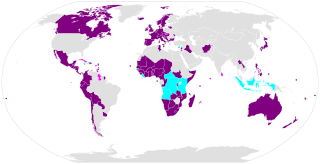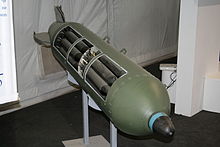
A bomb is an explosive weapon that uses the exothermic reaction of an explosive material to provide an extremely sudden and violent release of energy. Detonations inflict damage principally through ground- and atmosphere-transmitted mechanical stress, the impact and penetration of pressure-driven projectiles, pressure damage, and explosion-generated effects. Bombs have been utilized since the 11th century starting in East Asia.

A cluster munition is a form of air-dropped or ground-launched explosive weapon that releases or ejects smaller submunitions. Commonly, this is a cluster bomb that ejects explosive bomblets that are designed to kill personnel and destroy vehicles. Other cluster munitions are designed to destroy runways or electric power transmission lines.
A bunker buster is a type of munition that is designed to penetrate hardened targets or targets buried deep underground, such as military bunkers.

The Butterfly Bomb was a German 2-kilogram (4.4 lb) anti-personnel submunition used by the Luftwaffe during the Second World War. It was so named because the thin cylindrical metal outer shell which hinged open when the bomblet deployed gave it the superficial appearance of a large butterfly. The design was very distinctive and easy to recognise. SD 2 bomblets were not dropped individually, but were packed into containers holding between 6 and 108 submunitions e.g. the AB 23 SD 2 and AB 250-3 submunition dispensers. The SD 2 submunitions were released after the container was released from the aircraft and had burst open. Because SD 2s were always dropped in groups the discovery of one unexploded SD 2 was a reliable indication that others had been dropped nearby. This bomb type was one of the first cluster bombs ever used in combat and it proved to be a highly effective weapon. The bomb containers that carried the SD 2 bomblets and released them in the air were nicknamed the "Devil's Eggs" by Luftwaffe air and ground crew.

Named after a mythical medieval French sword, the Durandal is an anti-runway penetration bomb developed by the French company Matra, designed to destroy airport runways and exported to several countries. A simple crater in a runway could be just filled in, so the Durandal uses two explosions to displace the concrete slabs of a runway, thus making the runway much more difficult to repair.

The CBU-97 Sensor Fuzed Weapon is a United States Air Force 1,000-pound (450 kg)-class freefall Cluster Bomb Unit. It was developed and produced by Textron Defense Systems. A CBU-97 used in conjunction with the Wind Corrected Munitions Dispenser guidance tail kit is converted to a precision-guided weapon, and the combination is designated CBU-105.
Offensive counter-air(OCA) is a military term for the suppression of an enemy's military air power, primarily through ground attacks targeting enemy air bases: disabling or destroying parked aircraft, runways, fuel facilities, hangars, air traffic control facilities and other aviation infrastructure. Ground munitions like bombs are typically less expensive than more sophisticated air-to-air munitions, and a single ground munition can destroy or disable multiple aircraft in a very short time whereas aircraft already flying must typically be shot down one at a time. Enemy aircraft already flying also represent an imminent threat as they can usually fire back, and therefore destroying them before they can take off minimizes the risk to friendly aircraft.

The Mk 20 Rockeye II, CBU-99 Rockeye II, and CBU-100 Rockeye II comprise an American cluster bomb family which are employed primarily in an anti-tank mode against armored vehicles.

BL755 is a cluster bomb developed by Hunting Aircraft that contains 147 parachute-retarded high explosive anti-tank (HEAT) submunitions. Its primary targets are armoured vehicles and tanks with secondary soft target capabilities. It entered service with the Royal Air Force (RAF) in 1973.

Operation Focus was the opening airstrike by Israel at the start of the Six-Day War in 1967. It is sometimes referred to as the "Sinai Air Strike". At 07:45 on 5 June 1967, the Israeli Air Force (IAF) under Maj. Gen. Mordechai Hod launched a massive airstrike that destroyed the majority of the Egyptian Air Force on the ground. Following Syrian and Jordanian attacks in retaliation, the Israeli Air Force proceeded to bomb air bases in those countries. By noon, the Egyptian, Jordanian and Syrian Air Forces, totaling about 450 aircraft, were destroyed. It was also very successful in disabling 18 airfields in Egypt, hindering Egyptian air operations for the duration of the war, and remains one of the most successful air attack campaigns in military history.

The JP233, originally known as the Low-Altitude Airfield Attack System(LAAAS), is a British submunition delivery system. It consists of large dispenser pods carrying several hundred submunitions designed to attack runways.

The CBU-24 is an unguided, aircraft delivered anti-personnel and anti-materiel weapon developed by the United States. Because it is an unguided weapon, the CBU-24 can be carried and dropped by any aircraft capable of carrying standard "dumb" or "iron" bombs.
The CBU-87 Combined Effects Munition (CEM) is a cluster bomb used by the United States Air Force, developed by Aerojet General/Honeywell and introduced in 1986 to replace the earlier cluster bombs used in the Vietnam War. CBU stands for Cluster Bomb Unit. When the CBU-87 is used in conjunction with the Wind Corrected Munitions Dispenser guidance tail kit, it becomes much more accurate, and is designated CBU-103.

The BLU-97/B Combined Effects Bomb is the submunition used in several cluster bomb type weapon systems, mainly the CBU-87 and its precision-guided version CBU-103. When the bomblets fall, they separate from the main bomb and independently free fall to the ground. They contain an inflatable bag (ballute) on the top of them, which slows them down and spreads them out. Once the bomblets reach a force of 6 Gs they arm themselves. As the bomblets fall, they are also spinning. Arming takes about 2.6 seconds. They have a combined shaped charge, fragmentation and incendiary effect on the target. It is very effective against and mainly used for anti-personnel, anti-materiel, and anti-armor.
The CBU-55 was a cluster bomb fuel–air explosive that was developed during the Vietnam War by the United States Air Force, and was used only infrequently in that conflict. Unlike most incendiaries, which contained napalm or phosphorus, the 750-pound (340 kg) CBU-55 was fueled primarily by propane. Described as "the most powerful non-nuclear weapon in the U.S. arsenal," the device was one of the more powerful conventional weapons designed for warfare.

The Convention on Cluster Munitions (CCM) is an international treaty that prohibits all use, transfer, production, and stockpiling of cluster munitions, a type of explosive weapon which scatters submunitions ("bomblets") over an area. Additionally, the convention establishes a framework to support victim assistance, clearance of contaminated sites, risk reduction education, and stockpile destruction. The convention was adopted on 30 May 2008 in Dublin, and was opened for signature on 3 December 2008 in Oslo. It entered into force on 1 August 2010, six months after it was ratified by 30 states. As of December 2023, a total of 124 states are committed to the goal of the convention, with 112 states that have ratified it, and 12 states that have signed the convention but not yet ratified it.

The MW-1 is a German munitions dispenser similar to the British JP233. It is designed to be carried on the Tornado IDS, although it can be carried on the Lockheed F-104 Starfighter and the McDonnell Douglas F-4 Phantom II. The MW-1 started to be phased out after the German Government ratified the Convention on Cluster Munitions in 2009.

A precision-guided munition is a guided munition intended to precisely hit a specific target, to minimize collateral damage and increase lethality against intended targets. During the First Gulf War guided munitions accounted for only 9% of weapons fired, but accounted for 75% of all successful hits. Despite guided weapons generally being used on more difficult targets, they were still 35 times more likely to destroy their targets per weapon dropped.
The BAP 100 is a French anti-runway cluster bomb developed in the mid-1970s, and which entered service with the French Air Force in the early 1980s. The bomb consists of eighteen submunitions, arranged in a cluster. Accelerated by an internal propulsion system, the munitions are designed to ensure total runway destruction in a single pass by aircraft.
The DRDO Smart Anti-Airfield Weapon (SAAW) is a long-range precision-guided anti-airfield weapon developed by India's Defence Research and Development Organisation (DRDO). It is designed to be capable of engaging ground targets with high precision up to a range of 100 kilometres (62 mi).














